This is the Italeri 0299 kit in 1/35 scale, of the ‘German Sturmmörser Tiger mit 38 cm RW 61’.

History
Only few units of the Sturmtiger were built and were mainly used in 1994 at the Eastern front.
This is the Italeri 0299 kit in 1/35 scale, of the ‘German Sturmmörser Tiger mit 38 cm RW 61’.

Only few units of the Sturmtiger were built and were mainly used in 1994 at the Eastern front.
This is the Trumpeter 00209 kit in 1/35 scale, of the ‘German Mörser Karl-Gerat 040/041 on railway transport carrier’.
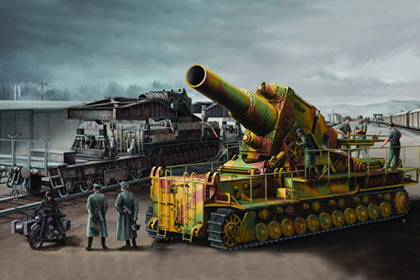
At a conference with Hitler in March 1943, it was stated that the first 54cm Gerät 041 would be delivered by June 1943, and the third, by mid-August. The 60cm and 54cm barrels appear to have been interchanged as required. In 1945, US forces captured vehicle II with a 60cm, and vehicle V with a 54cm. The prototype chassis, built in 1939, had eight road wheels with external swing arms. production Karl had eleven road wheels.
Ammunition was transported in a tracked Munitionsschlepper converted from the Pz.Kpfw.IV, four rounds in each Schlepper. For the 60cm Gerät 040, the s Be Granate weighed 2.117 tons and the Ie Be Granate, 1.70 tons; in this case of the 54cm Gerät 041, 1.58 tons and 1.25 tons respectively. Maximum rate of the fire was 6 rph (rounds per hour ). Guns I-IV went to the Russian Front in July 1941 with the 628th schwere Artillerie Abteilung.
They saw action at various sites, including Lemburg in that year. The best known action was against Sevastopol in 1942. Later, four guns were issued to the 833rd schwere Artillerie Abteilung (mot). These guns had the names Adam, Eve (1st Batt.) and Thor, Odin (2nd Batt.) The names for guns V and VI were Loki and Ziu.
This is the Trumpeter 00215 kit in 1/35 scale, of the ‘German Mörser Karl – Great 040/041’.
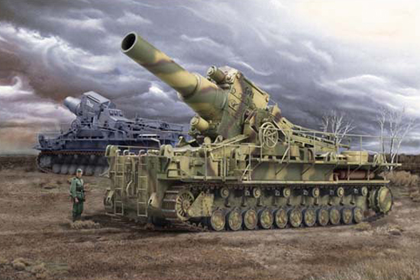
At a conference with Hitler in March 1943, it was stated that the first 54cm Gerat 041 would be delivered by June 1943, and the third, by mid-August. The 60cm and 54cm barrels appear to have been interchanged as required. In 1945, US forces captured vehicle II with a 60cm, and vehicle V with a 54cm. The prototype chassis, built in 1939, had eight road wheels with external swing arms. Production Karl had eleven road wheels.
Ammunition was transported in a tracked Munitionsschlepper converted from the Pz.Kpfw.IV, four rounds in each Schlepper. For the 60cm Gerat 040, the s Be Granate weighed 2.117 tons and the Ie Be Granate, 1.70 tons; in this case of the 54cm Gerat 041, 1.58 tons and 1.25 tons respectively. Maximum rate of the fire was 6 rph (rounds per hour). Guns I-IV went to the Russian Front in July 1941 with the 628th schwere Artillerie Abteilung. They saw action at various sites, including Lemburg in that year.
The best known action was against Sevastopol in 1942. Later, four guns were issued to the 833rd schwere Artillerie Abteilung (mot). These guns had the names Adam, Eve (1st Batt.) and Thor, Odin (2nd Batt.) The names for guns V and VI were Loki and Ziu.
This is the Trumpeter 00208 kit in 1/35 scale, of the ‘German Mörser Karl-Gerat 040/041 on railway transport carrier – Initial version’.
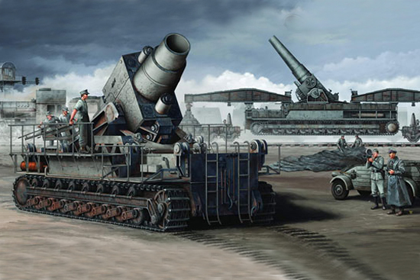
At a conference with Hitler in March 1943, it was stated that the first 54cm Gerät 041 would be delivered by June 1943, and the third, by mid-August. The 60cm and 54cm barrels appear to have been interchanged as required. In 1945, US forces captured vehicle II with a 60cm, and vehicle V with a 54cm. The prototype chassis, built in 1939, had eight road wheels with external swing arms. Production Karl had eleven road wheels.
Ammunition was transported in a tracked Munitionsschlepper converted from the PzKpfw IV, four rounds in each Schlepper. For the 60cm Gerät 040, the s Be Granate weighed 2.117 tons and the Ie Be Granate, 1.70 tons; in this case of the 54cm Gerät 041, 1.58 tons and 1.25 tons respectively. Maximum rate of the fire was 6 rph (rounds per hour). Guns I-IV went to the Russian Front in July 1941 with the 628th schwere Artillerie Abteilung. They saw action at various sites, including Lemburg in that year.
The best known action was against Sevastopol in 1942. Later, four guns were issued to the 833rd schwere Artillerie Abteilung (mot). These guns had the names Adam, Eve (1st Batt.) and Thor, Odin (2nd Batt.) The names for guns V and VI were Loki and Ziu.
This is the Trumpeter 02313 kit in 1/35 scale, of the ‘German 17 cm Kanone 18’.
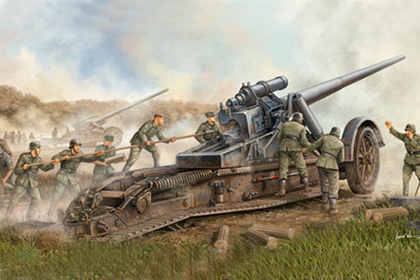
Although it was technically an excellent weapon, it was expensive, difficult to maneuver, very slow to set up and tear down; many were lost when their crew had either to abandon them or to risk capture by advancing allied troops.
This is the Trumpeter 02314 kit in 1/35 scale, of the ‘German 21 cm Mörser 18’.
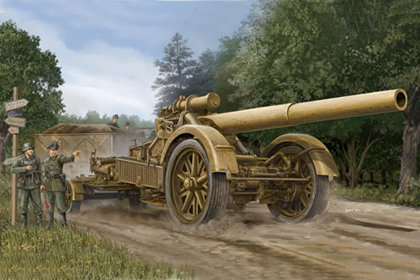
This carriage was also used for the 17 cm Kanone 18 in Mörserlafette and the 15 cm Schnelladekanone C/28 in Mörserlafette. The Mrs 18 was an enormous weapon that was transported in two pieces, as was common for such large weapons. For travel the barrel was slid on to a separate trailer. The carriage carried an integral firing platform that was lowered to the ground when emplacing the howitzer.
The wheels were then cranked up off the ground and it was now ready for firing. A rear castor-wheel jack was used to raise the rear spade off the ground if the gun needed to be traversed more than allowed by the 16° allowed by the mount proper.